seats TOYOTA FJ CRUISER 2010 1.G Owners Manual
[x] Cancel search | Manufacturer: TOYOTA, Model Year: 2010, Model line: FJ CRUISER, Model: TOYOTA FJ CRUISER 2010 1.GPages: 439, PDF Size: 11.02 MB
Page 2 of 439
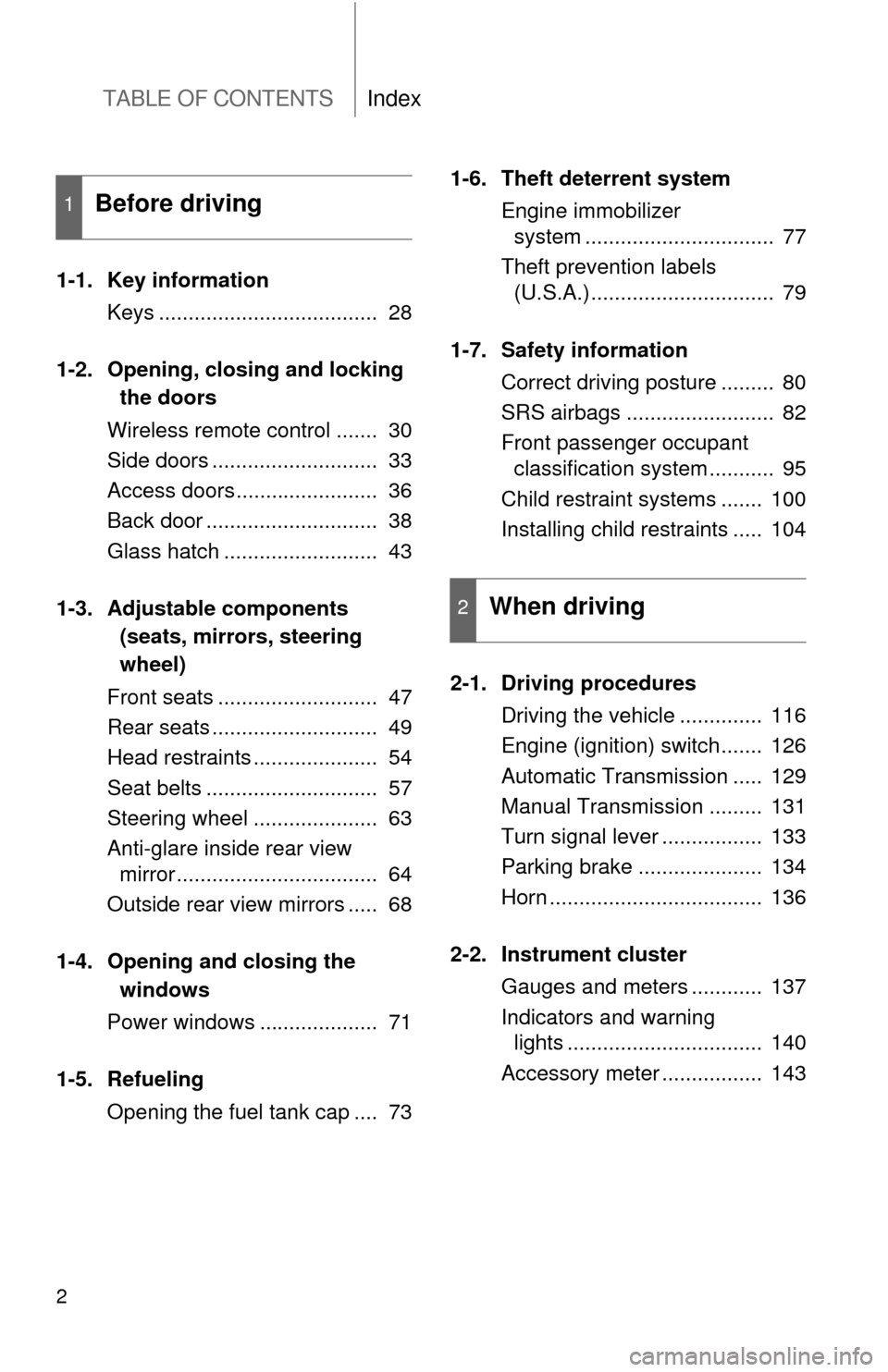
TABLE OF CONTENTSIndex
2
1-1. Key information
Keys ..................................... 28
1-2. Opening, closing and locking
the doors
Wireless remote control ....... 30
Side doors ............................ 33
Access doors........................ 36
Back door ............................. 38
Glass hatch .......................... 43
1-3. Adjustable components
(seats, mirrors, steering
wheel)
Front seats ........................... 47
Rear seats ............................ 49
Head restraints ..................... 54
Seat belts ............................. 57
Steering wheel ..................... 63
Anti-glare inside rear view
mirror .................................. 64
Outside rear view mirrors ..... 68
1-4. Opening and closing the
windows
Power windows .................... 71
1-5. Refueling
Opening the fuel tank cap .... 731-6. Theft deterrent system
Engine immobilizer
system ................................ 77
Theft prevention labels
(U.S.A.)............................... 79
1-7. Safety information
Correct driving posture ......... 80
SRS airbags ......................... 82
Front passenger occupant
classification system ........... 95
Child restraint systems ....... 100
Installing child restraints ..... 104
2-1. Driving procedures
Driving the vehicle .............. 116
Engine (ignition) switch....... 126
Automatic Transmission ..... 129
Manual Transmission ......... 131
Turn signal lever ................. 133
Parking brake ..................... 134
Horn .................................... 136
2-2. Instrument cluster
Gauges and meters ............ 137
Indicators and warning
lights ................................. 140
Accessory meter ................. 143
1Before driving
2When driving
Page 10 of 439
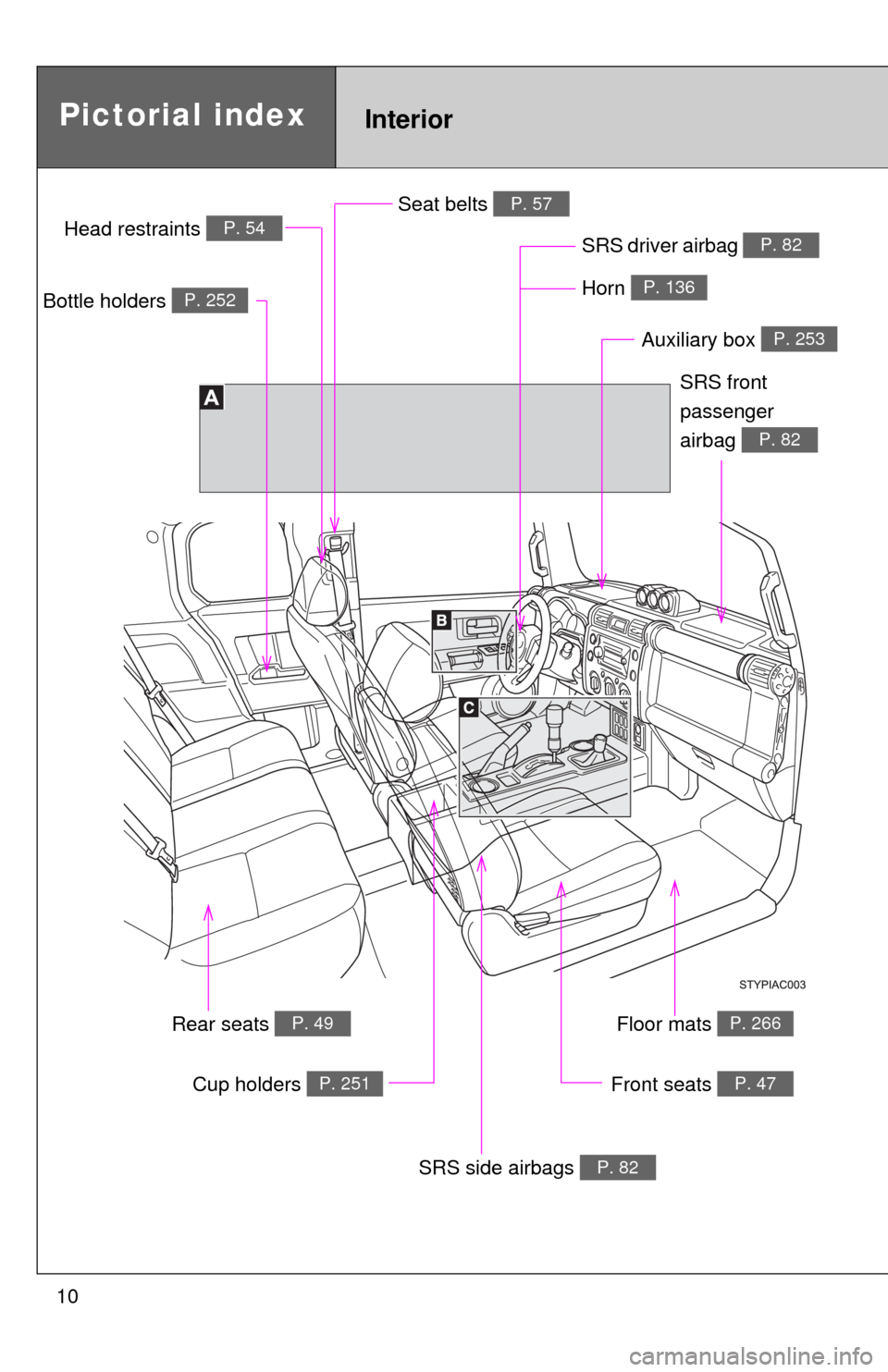
10
Pictorial indexInterior
Seat belts P. 57
SRS driver airbag P. 82Head restraints P. 54
Bottle holders P. 252
Cup holders P. 251
SRS side airbags P. 82
Floor mats P. 266
SRS front
passenger
airbag
P. 82
Auxiliary box P. 253
Rear seats P. 49
Horn P. 136
Front seats P. 47
Page 27 of 439
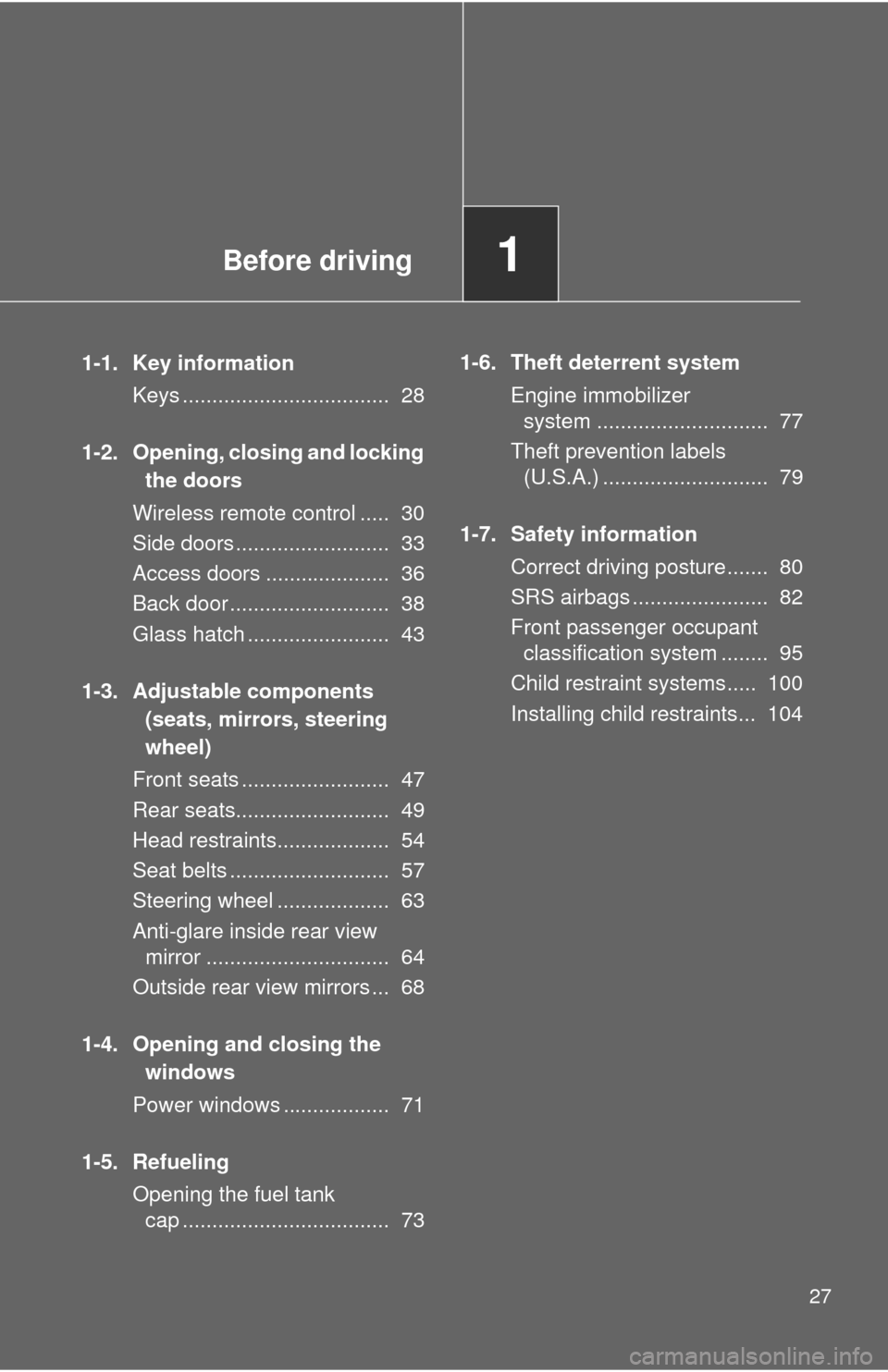
Before driving1
27
1-1. Key information
Keys ................................... 28
1-2. Opening, closing and locking
the doors
Wireless remote control ..... 30
Side doors .......................... 33
Access doors ..................... 36
Back door ........................... 38
Glass hatch ........................ 43
1-3. Adjustable components
(seats, mirrors, steering
wheel)
Front seats ......................... 47
Rear seats.......................... 49
Head restraints................... 54
Seat belts ........................... 57
Steering wheel ................... 63
Anti-glare inside rear view
mirror ............................... 64
Outside rear view mirrors ... 68
1-4. Opening and closing the
windows
Power windows .................. 71
1-5. Refueling
Opening the fuel tank
cap ................................... 731-6. Theft deterrent system
Engine immobilizer
system ............................. 77
Theft prevention labels
(U.S.A.) ............................ 79
1-7. Safety information
Correct driving posture....... 80
SRS airbags ....................... 82
Front passenger occupant
classification system ........ 95
Child restraint systems..... 100
Installing child restraints... 104
Page 47 of 439
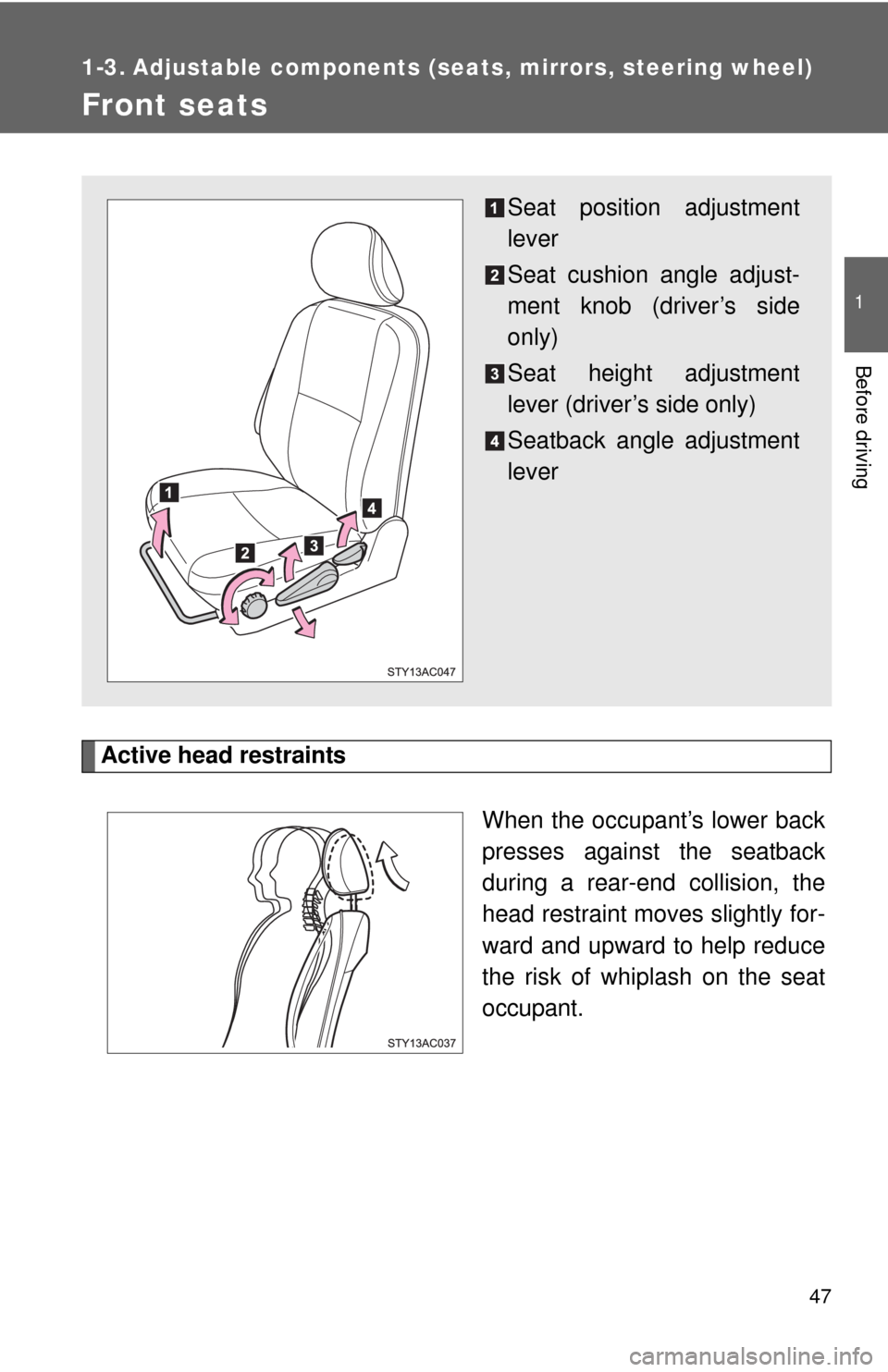
47
1
Before driving
1-3. Adjustable components (seats, mirrors, steering wheel)
Front seats
Active head restraints
When the occupant’s lower back
presses against the seatback
during a rear-end collision, the
head restraint moves slightly for-
ward and upward to help reduce
the risk of whiplash on the seat
occupant.
Seat position adjustment
lever
Seat cushion angle adjust-
ment knob (driver’s side
only)
Seat height adjustment
lever (driver’s side only)
Seatback angle adjustment
lever
Page 48 of 439
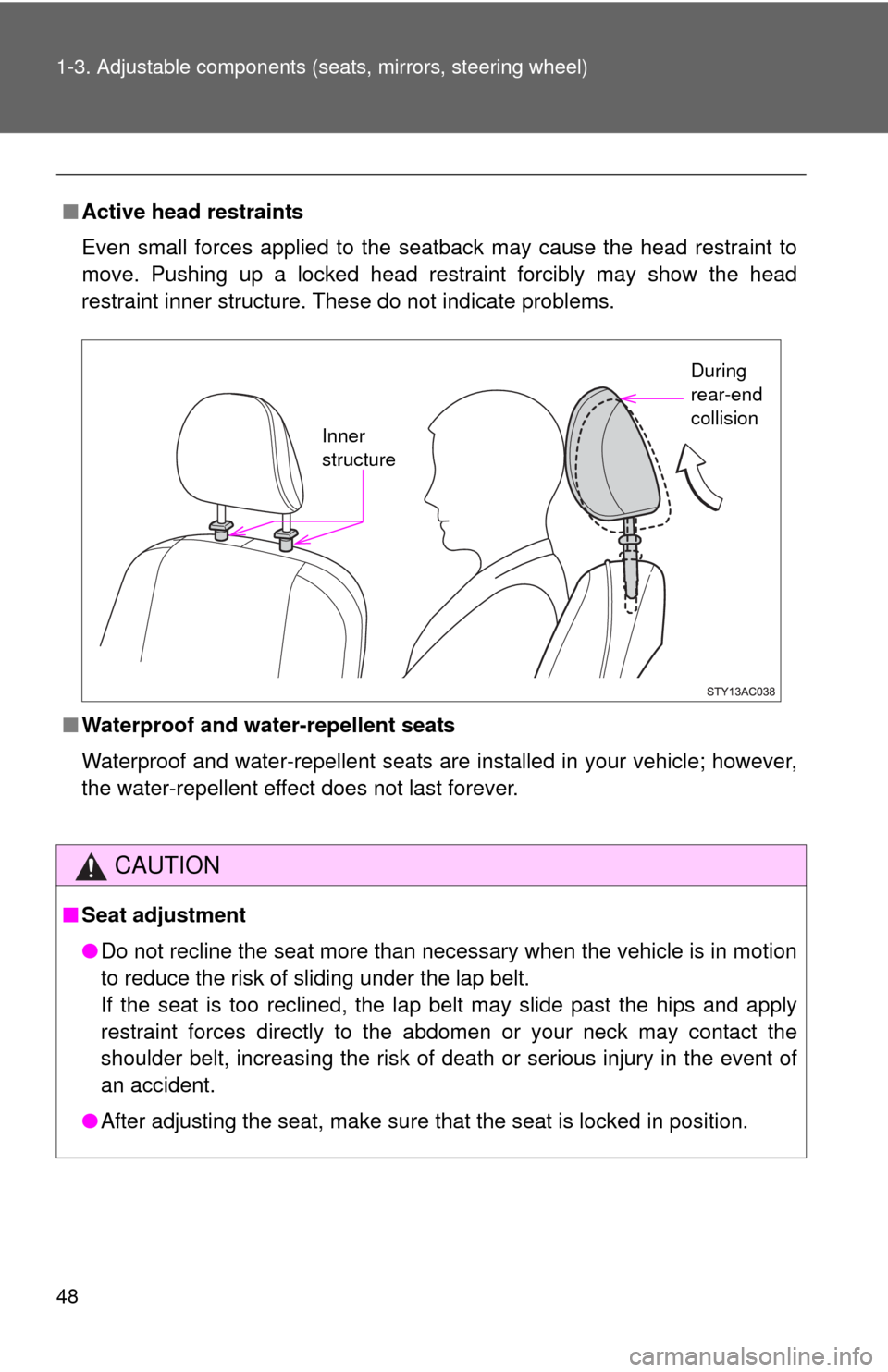
48 1-3. Adjustable components (seats, mirrors, steering wheel)
■Active head restraints
Even small forces applied to the seatback may cause the head restraint to
move. Pushing up a locked head restraint forcibly may show the head
restraint inner structure. These do not indicate problems.
■Waterproof and water-repellent seats
Waterproof and water-repellent seats are installed in your vehicle; however,
the water-repellent effect does not last forever.
CAUTION
■Seat adjustment
●Do not recline the seat more than necessary when the vehicle is in motion
to reduce the risk of sliding under the lap belt.
If the seat is too reclined, the lap belt may slide past the hips and apply
restraint forces directly to the abdomen or your neck may contact the
shoulder belt, increasing the risk of death or serious injury in the event of
an accident.
●After adjusting the seat, make sure that the seat is locked in position.
Inner
structure
During
rear-end
collision
Page 49 of 439
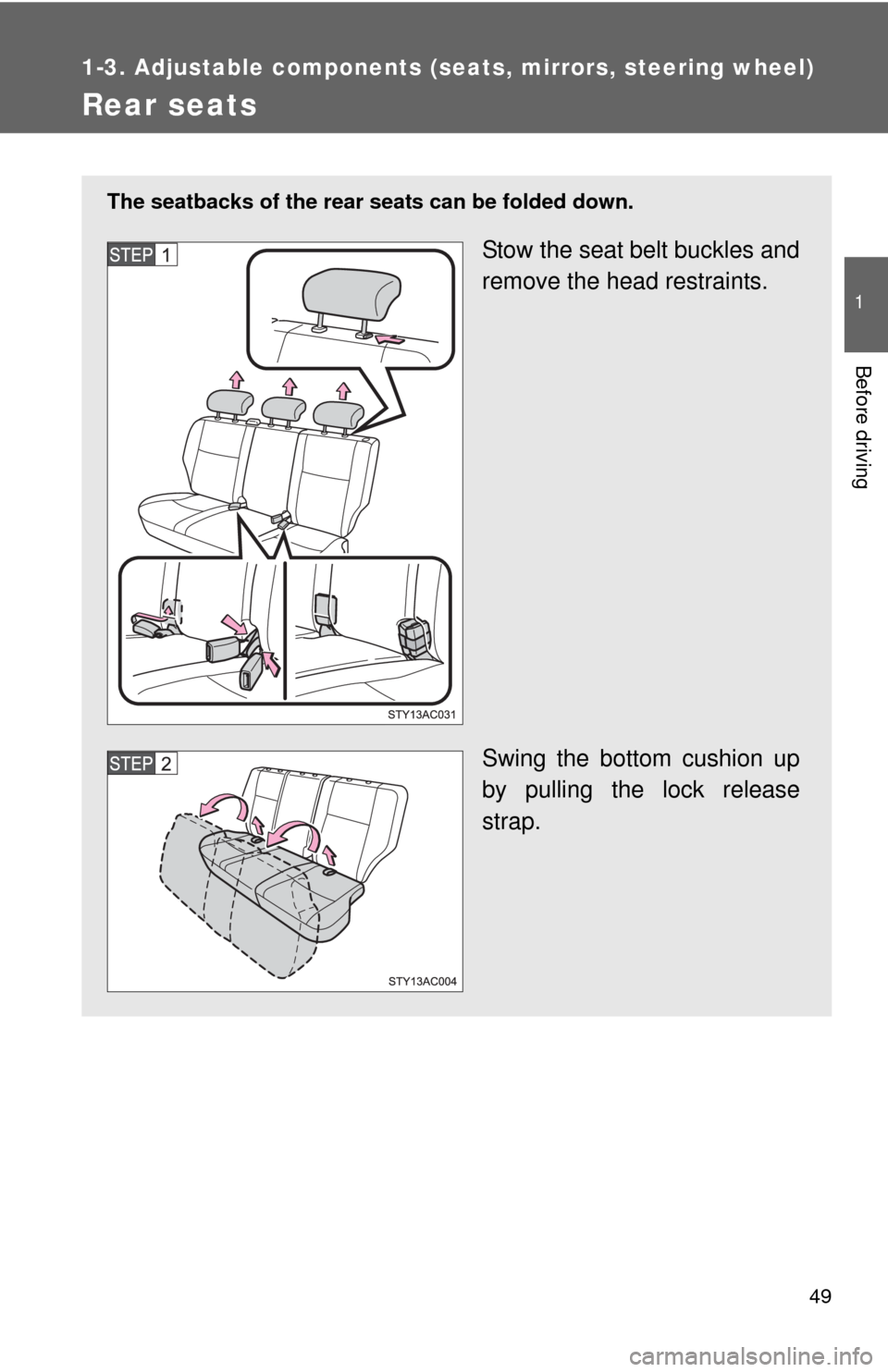
49
1
1-3. Adjustable components (seats, mirrors, steering wheel)
Before driving
Rear seats
The seatbacks of the rear seats can be folded down.
Stow the seat belt buckles and
remove the head restraints.
Swing the bottom cushion up
by pulling the lock release
strap.
Page 50 of 439
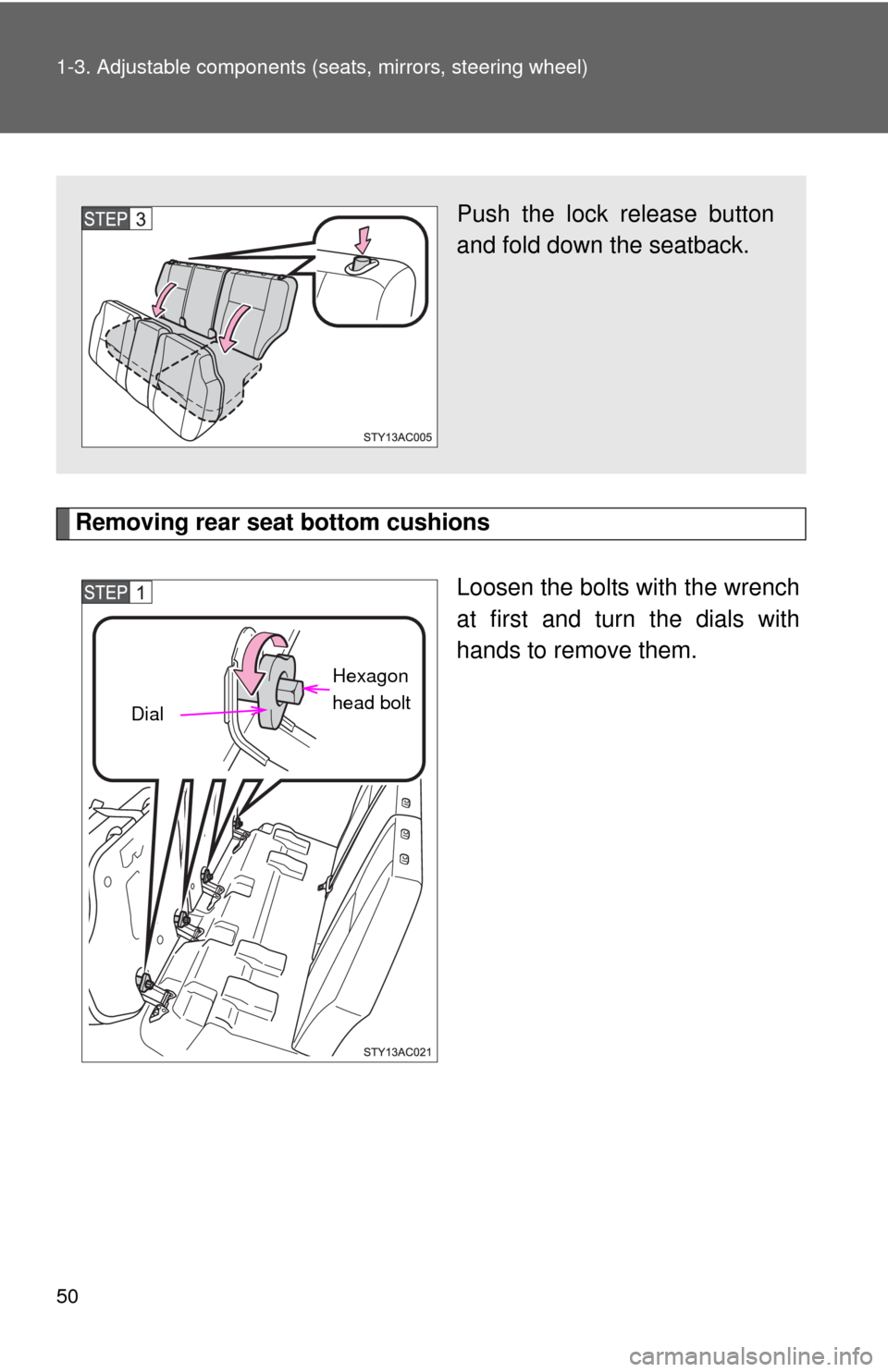
50 1-3. Adjustable components (seats, mirrors, steering wheel)
Removing rear seat bottom cushions
Loosen the bolts with the wrench
at first and turn the dials with
hands to remove them.
Push the lock release button
and fold down the seatback.
Hexagon
head bolt
Dial
Page 51 of 439
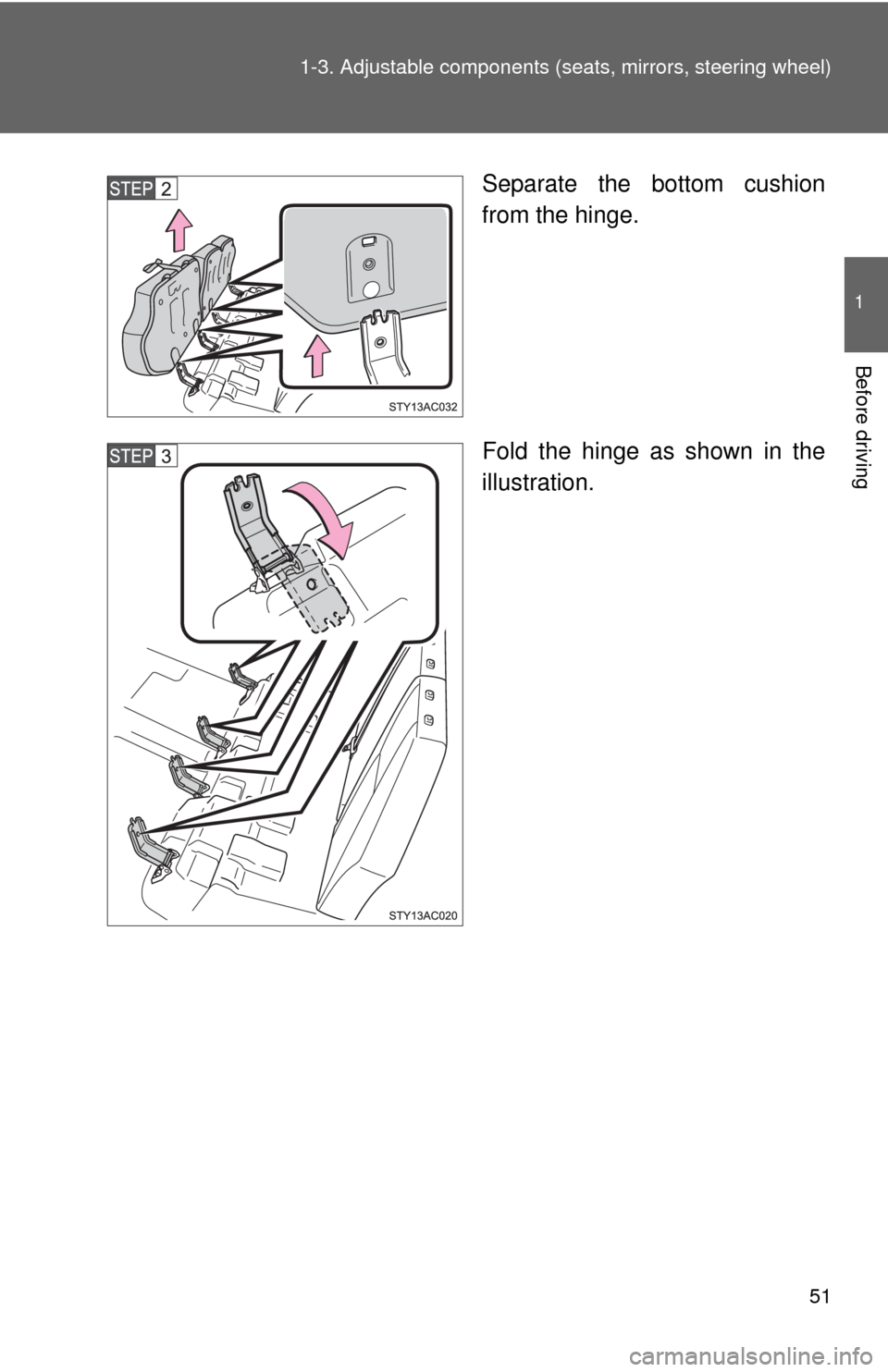
51 1-3. Adjustable components (seats, mirrors, steering wheel)
1
Before driving
Separate the bottom cushion
from the hinge.
Fold the hinge as shown in the
illustration.
Page 52 of 439
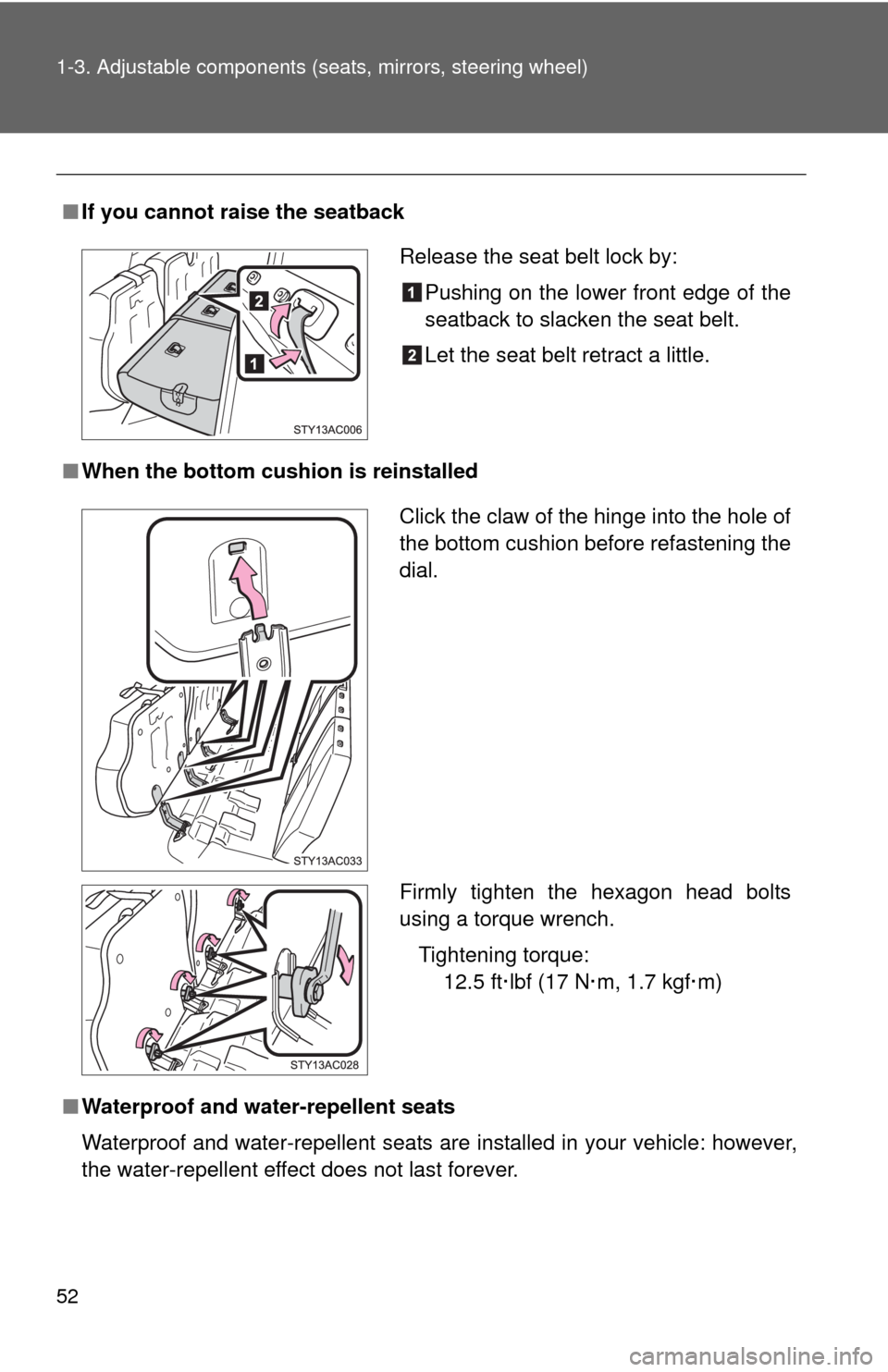
52 1-3. Adjustable components (seats, mirrors, steering wheel)
■If you cannot raise the seatback
■When the bottom cushion is reinstalled
■Waterproof and water-repellent seats
Waterproof and water-repellent seats are installed in your vehicle: however,
the water-repellent effect does not last forever.
Release the seat belt lock by:
Pushing on the lower front edge of the
seatback to slacken the seat belt.
Let the seat belt retract a little.
Click the claw of the hinge into the hole of
the bottom cushion before refastening the
dial.
Firmly tighten the hexagon head bolts
using a torque wrench.
Tightening torque:
12.5 ft·lbf (17 N·m, 1.7 kgf·m)
Page 53 of 439
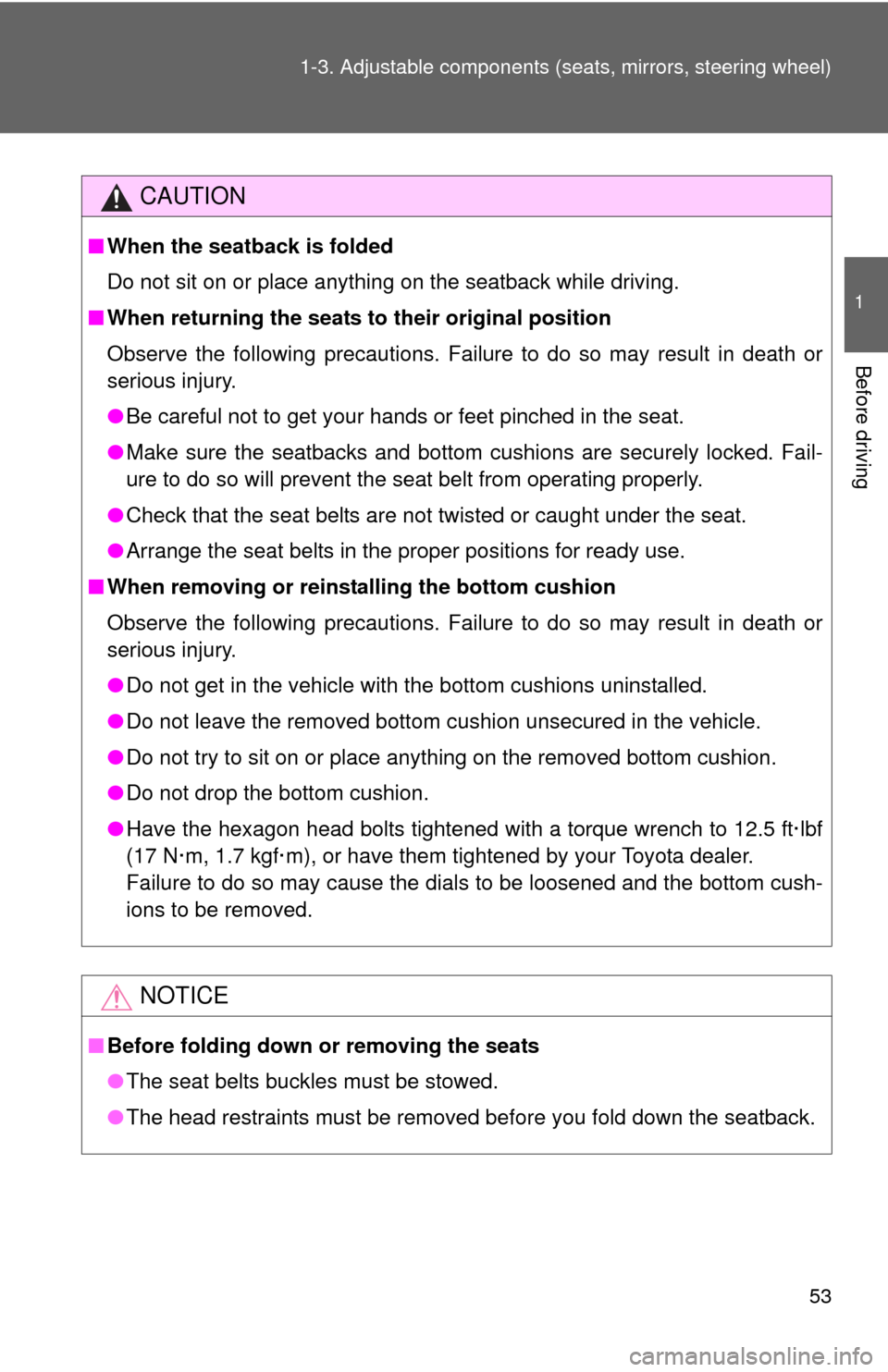
53 1-3. Adjustable components (seats, mirrors, steering wheel)
1
Before driving
CAUTION
■When the seatback is folded
Do not sit on or place anything on the seatback while driving.
■When returning the seats to their original position
Observe the following precautions. Failure to do so may result in death or
serious injury.
●Be careful not to get your hands or feet pinched in the seat.
●Make sure the seatbacks and bottom cushions are securely locked. Fail-
ure to do so will prevent the seat belt from operating properly.
●Check that the seat belts are not twisted or caught under the seat.
●Arrange the seat belts in the proper positions for ready use.
■When removing or reinstalling the bottom cushion
Observe the following precautions. Failure to do so may result in death or
serious injury.
●Do not get in the vehicle with the bottom cushions uninstalled.
●Do not leave the removed bottom cushion unsecured in the vehicle.
●Do not try to sit on or place anything on the removed bottom cushion.
●Do not drop the bottom cushion.
●Have the hexagon head bolts tightened with a torque wrench to 12.5 ft·lbf
(17 N·m, 1.7 kgf·m), or have them tightened by your Toyota dealer.
Failure to do so may cause the dials to be loosened and the bottom cush-
ions to be removed.
NOTICE
■Before folding down or removing the seats
●The seat belts buckles must be stowed.
●The head restraints must be removed before you fold down the seatback.